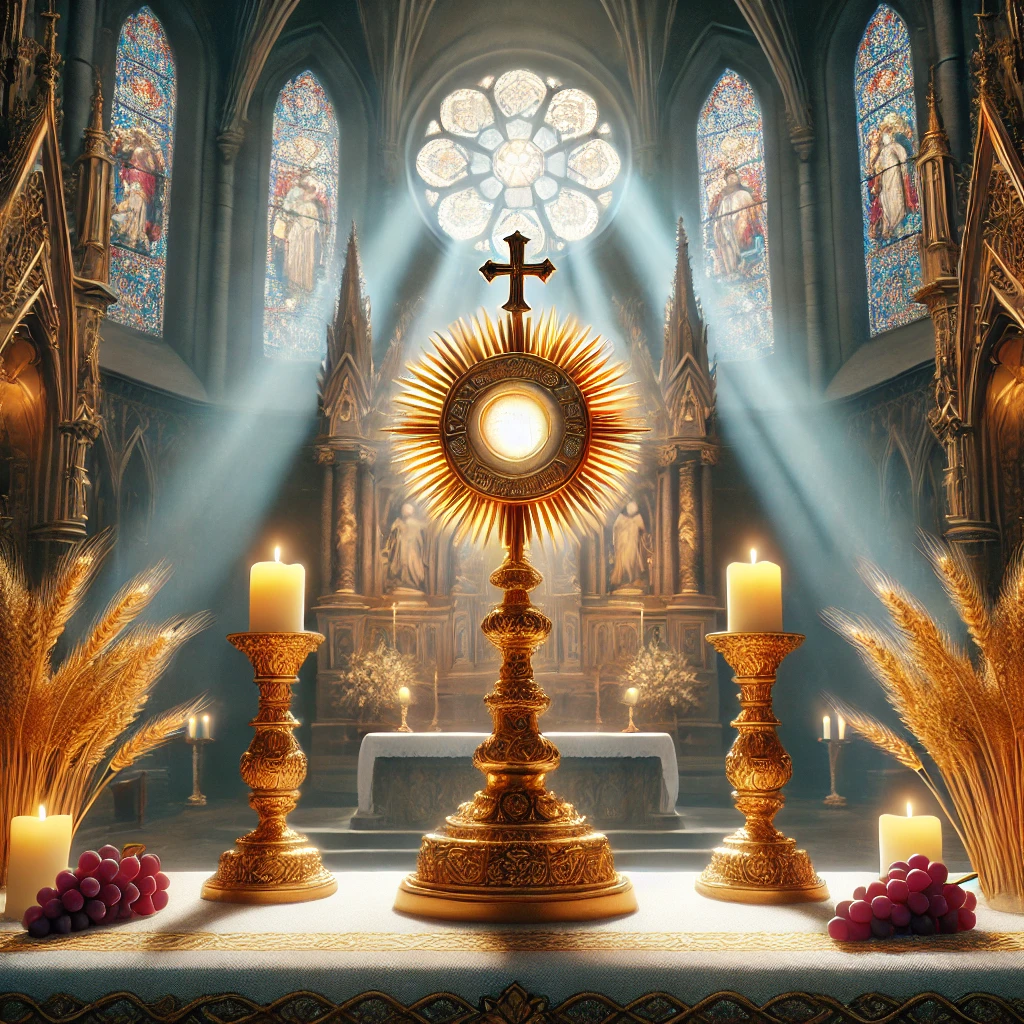
Objection 1: It seems that Christ is not truly present in the Eucharist. For the senses perceive only bread and wine, and faith cannot contradict sense. Therefore, it appears that the Eucharist is merely symbolic.
Objection 2: Further, Christ ascended into heaven and is seated at the right hand of the Father (Mark 16:19). Therefore, His body cannot be present in multiple places at once, such as in the Eucharist.
Objection 3: Further, in John 6:63, Christ says, "The spirit gives life; the flesh profits nothing." Therefore, it seems inappropriate to claim that Christ’s flesh is present in the Eucharist in a way that profits salvation.
On the contrary, Christ Himself says, "This is my body" (Matthew 26:26) and "This is my blood" (Matthew 26:28). The Apostle Paul also affirms, "For anyone who eats and drinks without discerning the body eats and drinks judgment on himself" (1 Corinthians 11:29). Therefore, Christ’s true presence in the Eucharist must be affirmed.
I answer that, according to Catholic teaching, Christ is truly, really, and substantially present in the Eucharist under the appearances of bread and wine. This doctrine is called transubstantiation and is rooted in Scripture, Tradition, and magisterial teaching.
Reply to Objection 1: Although the senses perceive only the accidents of bread and wine, faith affirms the substantial change that occurs through the power of Christ’s words spoken at the consecration. As St. Ambrose states: "If the word of the Lord Jesus is so powerful as to bring into existence things which were not, then how much more powerful must it be to change what already exists into something else?" (De Mysteriis 9.54). Thus, the Eucharist is not contrary to sense but surpasses it, requiring faith to perceive the mystery.
Reply to Objection 2: Christ’s ascension does not preclude His ability to be present sacramentally in the Eucharist. Through the divine power of His glorified body, Christ is present in the sacrament not by local extension, as in a physical place, but by sacramental mode. St. Thomas explains: "Christ is not in this sacrament in His proper species, but in a sacramental mode" (Summa Theologica, III, Q. 76, Art. 1). Therefore, Christ’s presence in the Eucharist does not conflict with His ascension or His heavenly location.
Reply to Objection 3: Christ’s words in John 6:63 must be understood in their proper context. The statement, "The flesh profits nothing," refers to a carnal understanding of His words, not the spiritual reality of the Eucharist. Earlier in the same discourse, Christ declares, "For my flesh is true food, and my blood is true drink" (John 6:55). The Eucharist profits salvation because it is Christ’s life-giving presence, uniting believers to His redemptive sacrifice.
Scriptural Basis:
Matthew 26:26-28: "Take, eat; this is my body... Drink from it, all of you; for this is my blood."
John 6:55-56: "For my flesh is true food, and my blood is true drink. Whoever eats my flesh and drinks my blood remains in me, and I in them."
1 Corinthians 11:23-29: Paul’s teaching on the institution of the Eucharist and the necessity of discerning the body.
Historical Witnesses:
St. Ignatius of Antioch (c. 110 AD): "The Eucharist is the flesh of our Savior Jesus Christ" (Letter to the Smyrnaeans 7).
St. Justin Martyr (c. 155 AD): "This food is the flesh and blood of that Jesus who was made flesh" (First Apology 66).
St. Ambrose of Milan (4th century): "Before consecration it is bread; after consecration it becomes Christ’s Body" (De Mysteriis 9.54).
Catechism of the Catholic Church:
CCC 1374: "In the most blessed sacrament of the Eucharist, the Body and Blood, together with the soul and divinity, of our Lord Jesus Christ and, therefore, the whole Christ is truly, really, and substantially contained."
CCC 1376: Explains the doctrine of transubstantiation, emphasizing the substantial change of bread and wine into the Body and Blood of Christ.
Conclusion:
Christ’s presence in the Eucharist is a profound mystery grounded in His own words, supported by the testimony of the early Church Fathers, and articulated by the magisterium of the Church. This belief calls for faith and deep reverence, recognizing the Eucharist as the sacramental encounter with Christ’s real presence.
Works Cited
Catechism of the Catholic Church. 2nd ed., Libreria Editrice Vaticana, 1997.
The Holy Bible. Revised Standard Version, Catholic Edition, Ignatius Press, 2006.
Ignatius of Antioch. Letter to the Smyrnaeans. c. 110 AD.
Justin Martyr. First Apology. Translated by Alexander Roberts and James Donaldson, c. 155 AD.
Ambrose of Milan. De Mysteriis. Translated by T. Thompson, 4th century.
Aquinas, Thomas. Summa Theologica. Translated by Fathers of the English Dominican Province, Benziger Bros., 1947.